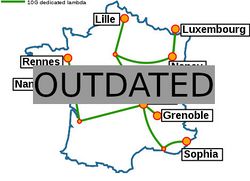Grid5000:Home
|
Grid'5000 is a large-scale and versatile testbed for experiment-driven research in all areas of computer science, with a focus on parallel and distributed computing including Cloud, HPC and Big Data and IA. Key features:
Grid'5000 is merging with FIT to build the SILECS Infrastructure for Large-scale Experimental Computer Science. Read an Introduction to SILECS (April 2018)
Older documents:
|
Random pick of publications
Five random publications that benefited from Grid'5000 (at least 2928 overall):
- Barbara Gendron, Gaël Guibon. SEC : contexte émotionnel phrastique intégré pour la reconnaissance émotionnelle efficiente dans la conversation. 35èmes Journées d'Études sur la Parole (JEP 2024) 31ème Conférence sur le Traitement Automatique des Langues Naturelles (TALN 2024) 26ème Rencontre des Étudiants Chercheurs en Informatique pour le Traitement Automatique des Langues (RECITAL 2024), Jul 2024, Toulouse, France. pp.219-233. hal-04623019 view on HAL pdf
- Clément Barthélemy, Francieli Zanon Boito, Emmanuel Jeannot, Guillaume Pallez, Luan Teylo. Implementation of an unbalanced I/O Bandwidth Management system in a Parallel File System. RR-9537, Inria. 2024. hal-04417412 view on HAL pdf
- Rodrigo Wilkens, Rémi Cardon, Amalia Todirascu, Núria Gala. 3rd Workshop on Tools and Resources for People with REAding DIfficulties (READI 2024). Workshop at the Language Resources and Evaluation Conference (LREC 2024) jointly organized by the ELRA Language Resources Association and the International Committee on Computational Linguistics, 2024, 978-2-493814-34-0. hal-04580167 view on HAL pdf
- Alexandre Sabbadin, Tom Guérout. Towards a Classification of Edge Service Orchestration Strategies Integrating Renewable Energy. 22nd International Conference on Service-Oriented Computing (ICSOC 2024), Dec 2024, Tunis (Tunisie), Tunisia. hal-05010531 view on HAL pdf
- Rahma Hellali, Zaineb Chelly Dagdia, Karine Zeitouni. A Multi-Objective Multi-Agent Interactive Deep Reinforcement Learning Approach for Feature Selection. International conference on neural information processing, Dec 2024, Auckland (Nouvelle Zelande), New Zealand. pp.15. hal-04723314 view on HAL pdf
Latest news
Failed to load RSS feed from https://www.grid5000.fr/mediawiki/index.php?title=News&action=feed&feed=atom: Error parsing XML for RSS
Grid'5000 sites
Current funding
As from June 2008, Inria is the main contributor to Grid'5000 funding.
INRIA |
CNRS |
UniversitiesUniversité Grenoble Alpes, Grenoble INP |
Regional councilsAquitaine |


